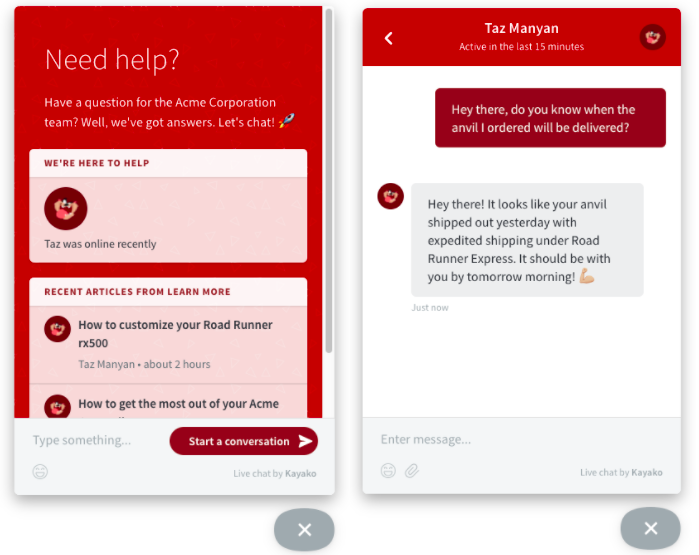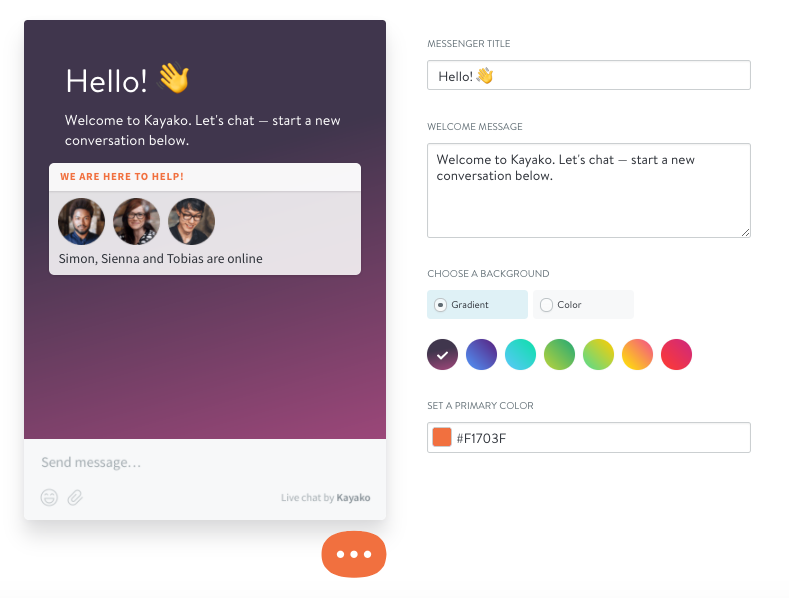Live chat functionality on websites should be hugely helpful, because it allows a customer support representative to help the user immediately.
Online live chat offers quick and easy access to a customer service department, the waiting times are usually minimal, and there are no call charges.
Win—win—win.
So, in theory, live chat should be highly effective…but it’s not:
- 38% of consumers are frustrated by poor user experience on live chat
- 56% of consumers cannot recall an exceptional live chat experience
- 43% of businesses know their user experience is not good enough
This is what we found asking 400 consumers and 100 businesses in our report on live chat statistics.
We knew we had to do something.
Let’s discuss how the chat view in a Messenger application can offer a terrific live chat experience, and how our very own Kayako Messenger fits into that.
Help the Customer Help Themselves
For the customer, the best live chat experience is one that wasn’t required to begin with.
Helping the user help themselves means that:
- Your team is saving both time and money
- It reduces waiting times for other customers and support inbound requests that your team would handle
- Customers don’t have to deal with a customer service agent at all (another win!)
Naturally, the best way to do this is to implement a community forum or a maintain a help section where users can search for their answer first, rather than wait in line to be “seen”.
It’s commonplace to make the user aware of FAQs before they try to initiate a live chat session, as it helps to weed out common questions and reduce the waiting time for those with deeper concerns. Long waiting times are stressful for both the customer and the agents, so eliminating that should be priority #1.
One approach you should never take, is to force the user to search for their question. Many users will have already searched for an answer before entering a live chat session, so forcing it upon them suggests that your human customer service respondents are unwilling, understaffed or non-existent.
It doesn’t make the brand look great and annoys the user, who may already be feeling frustrated.
Make the Live Chat Widget Easy to Find
Customers looking for help should be able to receive it almost instantly, especially if they have a deep concern and/or they’re unhappy about something. We don’t want to frustrate the user even more, so making it perfectly clear how the customer is to initiate a live chat session is super important.
You could insert a “Live Chat” link in the footer of the webpage, as this is where many users will think to look, but it’s even better if you include a chat icon fixed to the bottom-right corner of the screen (so that it’s immediately visible at all times). With Kayako Messenger, this is how we do it.

You also don’t have to leave the webpage you’re currently on, and you can continue browsing the businesses website while the live chat widget sits comfortably in the corner of the screen.

Set Expectations For the Live Chat Session
So the user wants to speak to a member of staff directly, and they’ve found the live chat feature. Before they dive in, they need to know what they can expect of your customer service team. If you don’t set expectations, the user/customer will define their own, and it’ll almost always be higher than what you’re able to offer. The “underpromise and overdeliver” concept applies here.
Rule #1: show opening times. If you don’t, users will assume that you’re there to help them 24/7, and feel abandoned when the customer support staff is having a well-earned break.
Rule #2: explain what you can help with now, what you can help with but will take time, and what you absolutely can’t help with (as well as an alternative solution). Some things require additional security measures, a member of the technical team, and some things simply take more time.
Here’s a video comparing what it’s like being the customer vs. what it’s like being the customer support representative—this should shed some light on the level of support you’ll be able to offer to customers.
During the Live Chat Session
A better user experience = a happier user. No surprise there, but when it comes to live chat experiences, this is ridiculously important. As mentioned before, when dealing with customers in a live chat session, there’s a reasonably high chance of the customer being upset already. They’re already on edge, possibly even considering not being a customer anymore. Bad user experience and unassuring communication could be the nudge that causes the customer to switch a competitor.
Let’s take a look at the various ways that we can ensure that doesn’t happen, using the Kayako live chat interface that can be visually customized to suit your brand and tone of voice.
Define the colors of your chat view
Color impacts the user’s emotions and overall perception of your brand. Also, an unattractive interface/layout will leave the customer feeling bored and uninspired, and thus further annoyed. During this critical time, we should be looking to impress (or re-impress) the user in multiple different ways.
With Kayako Messenger you can customize the colors of the live chat view to suit your brand. For the background, you can choose from a range of colors. Gradients are available too (this is when one color fades into another), and you can also apply subtle textures to this background. Finally, there’s the primary color for your brand that’s used on the user interface elements (buttons, etc).
Live chat windows don’t have to be dreadful. In fact, they can be pretty snazzy.


Writing the copy and establishing a tone of voice
Imagery and words should be used in harmony. Painting a picture of your brand using color (for example, blue tends to bring out feelings of friendliness and casualness) is only half of the story, we need to be establish a tone of voice when talking to customers. Your team probably has this nailed down already, so it’s simply a matter of tweaking a few customizations in Kayako Messenger.
What you can customize:
- Messenger Title: something like Hello! or Howdy! would suit here
- Welcome Message: a friendly, assuring message and any useful information the user should know before starting a live chat session
You can also display the friendly faces of the customer support agents currently online, to assure customers that their concerns aren’t being dealt with by robots with automated responses, but in fact real support staff. Another common concern is that companies tend to outsource customer service agents from abroad, so this will alleviate any suspicion. Full-transparency is key here.

Let the customer explain their issue
No live chat interface would be complete without the ability to upload images and screenshots. Explaining your issue isn’t always enough, sometimes we need to use screenshots to add further context, and with the Kayako live chat messenger, you’ll be able to do exactly that.
Don’t leave a message unseen
If the customer has left the website and an agent’s response goes unseen for 15 minutes, Kayako will intuitively send the reply to the customer’s email address instead. However, if the customer is still online, the agent will be able to have a real-time conversation with the customer right there and then.
Display recent tweets and help articles
You can display up to three recent tweets, and up to three recent articles from a relevant help section, letting the user know that your overall customer support expands multiple mediums. And who knows—the answer to the customer’s question might be contained within these six links!
Trade in your live chat tool for a modern messaging experience
Live chat functionality can be a lifesaver, but only when done right. Customers hate to wait, and they certainly hate waiting around to talk to a stranger on the telephone. Which is fine, because live chat, when implemented correctly, can be an instant gateway to a helpful customer service representative.
With Kayako Messenger specifically, you can customize the widget to suit the visual style and tone of voice that matches your brand and its values, and by taking onboard the UX advice outlined in this article, you can be sure that you’re offering the best customer service imaginable—before the live chat session, during the live chat session, and any time the customer needs your help after that.
Do you want to create effortless live chat experiences for your customers? Try out Kayako’s Messenger today on a 14 day free trial, or see it for yourself in a personalized demo.